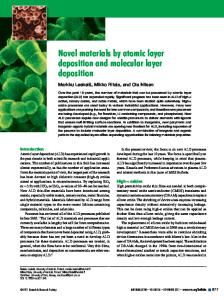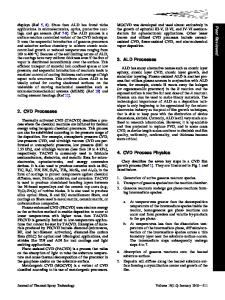Atomic Layer Deposition for the Conformal Coating of Nanoporous Materials
- PDF / 663,514 Bytes
- 5 Pages / 612 x 792 pts (letter) Page_size
- 38 Downloads / 459 Views
R12.6.1
Atomic Layer Deposition for the Conformal Coating of Nanoporous Materials Jeffrey W. Elam1, Guang Xiong1, Catherine Y. Han1, H. Hau Wang1, James P. Birrell1, John N. Hryn1, Michael J. Pellin1 John F. Poco2 and Joe H. Satcher, Jr2 1 Argonne National Laboratory, Argonne, IL 60439 2 Lawrence Livermore National Laboratory, Livermore, CA 94550 ABSTRACT Atomic layer deposition (ALD) is ideal for applying precise, conformal coatings over nanoporous materials. We have recently used ALD to coat two nanoporous solids: anodic aluminum oxide (AAO) and silica aerogels. AAO possesses hexagonally ordered pores with diameters d~10 nm and thicknesses L~70 microns. The AAO membranes were coated by ALD with successive layers of Al2O3, TiO2 and V2O5 to fabricate catalytic membranes. SEM, TEM and EDAX analysis of the membranes demonstrate that the ALD layers uniformly coat the extremely high aspect ratio (L/d~104) AAO pores. These catalytic membranes show remarkable selectivity in the oxidative dehydrogenation of cyclohexane. Additional AAO membranes coated with ALD Pd films show promise as hydrogen sensors. Silica aerogels have the lowest density and highest surface area of any solid material. Consequently, these materials serve as an excellent substrate to fabricate novel catalytic materials and gas sensors by ALD. In this study, both thin film and monolithic aerogels were coated by ZnO ALD and the properties of the aerogels were investigated as a function of the coating thickness.
INTODUCTION Atomic layer deposition (ALD) utilizes a binary reaction sequence of self-saturating chemical reactions between gaseous precursor molecules and a solid surface to deposit films in a monolayer-by-monolayer fashion [1]. These attributes make ALD an ideal method for applying precise, conformal coatings over nanoporous materials. In this manuscript, we describe recent work exploring the ALD coating of two nanoporous solids: anodic aluminum oxide (AAO) and silica aerogels. AAO membranes are synthesized by the anodization of aluminum metal [2], and consist of well-ordered hexagonal arrays of open pores with diameters d~10 nm and thicknesses L~70 microns. Silica aerogels are fabricated by the supercritical drying of a silica sol-gel [3] and consist of a randomly inter-connected network of fine filaments and particles. The AAO and silica aerogels have been successfully coated using ALD methods with a variety of oxide films including Al2O3, TiO2, V2O5 and ZnO as well as metallic Pd films. The ALD coated AAO and aerogel materials were characterized by SEM, TEM, EDAX, XRD ellipsometry, optical absorption and four-point probe conductivity measurements. The ALD/AAO materials are being employed as mesoporous catalytic membranes and gas sensors. The catalytic membranes were fabricated by applying successive coatings of Al2O3, TiO2 and V2O5 onto AAO membrane supports. These catalytic membranes show high selectivity for the oxidation dehydrogenation. Additional AAO membranes coated with ALD Pd exhibit fast response and high sensitivity for hydrogen det
Data Loading...











